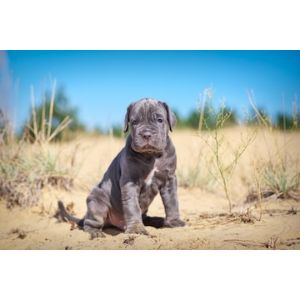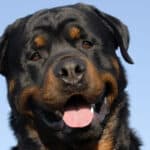
Big dogs can be best friends, loyal guard dogs, and intelligent members of our families. But how big is a Cane Corso? They’re popular pets, but how large are they, and what should you expect from their large-ness?
If you’re considering adding a Cane Corso to your family (or if you already have), it’s good to know what to expect ahead of time when it comes to size because they’re pretty large.
Read on for a deep dive into what to expect from their height, weight, health, exercise, lifestyle, and more.
Other articles you would like: Can A Cane Corso Live Outside? and Is Your Cane Corso Too Skinny?
Table of Contents
How Big Do Cane Corsos Get?

400;”>Cane Corsos can get pretty big as adults, not just in weight. They have large heads, a tall stature, and rippling muscles. Add that to their heavy weight (typically over 100 lbs), and they can be pretty intimidating.
They’re sometimes referred to as ‘bodyguard dogs’ for these reasons (plus they’re loyal). They do make excellent guard dogs.
Cane Corso Weight
Cane Corsos are large, muscular, heavy dogs. They have a solid build. They often weigh over 100 lbs, with males tending to weigh more than females.
As puppies, they typically gain between 2-4 pounds per week, and then those gains slow with age until they reach full size around 19 months of age.
Cane Corso Height
Cane Corsos are large, tall dogs. Some even call them giants, although they’re technically classified as ‘large,’ not ‘giant.’ The average height of a male Cane Corso is between 25-27.5”, and for a female is between 23.5-26”.
This height is typically calculated up to their shoulders at their highest point; the head isn’t factored into this measurement. This is often referred to as their withers height.
Here’s what you can expect as they grow from puppyhood:
- Two months: 12-15”
- Three months: 14-17”
- Four months: 16-20”
- Six months: 21-24”
- One year: 22-26”
- Two years: 23.5-27.5”
Many Cane Corsos will reach their full height around one year old, and some take longer, although most are finished growing by the time they’re two years old.
They typically finish growing weight-wise before they fill in their fully-grown chest and height measurements.
Cane Corso Size Comparison
How big are Cane Corsos compared to other dog breeds? They’re a form of Mastiff, so they are similar in size to other Mastiffs, such as the Bullmastiff, Neapolitan Mastiff, and Presa Canario (sometimes referred to as ‘King Corso’).
They are classified as large dogs, so other breeds are larger than them (classed as extra large).
Here are the classifications for reference:
- Small: 2-22 lbs
- Medium: 24-57 lbs
- Large: 59-99 lbs
- Giant or Extra Large: Over 100 lbs
Since Cane Corsos have a sizable average weight range of between 80-120 pounds, they are classified as a large breed dog, not giant or extra large. Some do refer to them as giant dogs, though.
Some larger breeds include the Anatolian Shepherd, Great Dane, Mastiff, Newfoundland, and Saint Bernard. The largest of these dogs can weigh up to 230 pounds.
Growth Expectations from Puppyhood
Both male and female Cane Corsos grow quite a bit within their first year of life, plateauing around 19 months at full adulthood.
Here are some expectations for growth during that time. Females tend to lean towards the bottom of these ranges, while males lean more towards the top of the ranges.
- One month: 16-28 lbs
- Two months: 26-35 lbs
- Three months: 32-40 lbs
- Four months: 37-46 lbs
- Five months: 43-55 lbs
- Six months: 51-65 lbs
- Seven months: 60-70 lbs
- Eight months: 65-80 lbs
- Nine months: 68-90 lbs
- Ten months: 75-95 lbs
- 11 months: 80-100 lbs
- 12 months: 85-105 lbs
- 19 months: 90-110 lbs
These, of course, aren’t exact numbers for every single Cane Corso, but it’s a good guideline to see at a glance if your dog is following the general rule of thumb.
If your dog isn’t within these ranges but is following his or her growth curve, you probably don’t have to worry.
It is good to know what to expect, so you can catch weight gain issues if they arise and get vet intervention sooner rather than later to help your dog.
What To Expect With a Full-Grown Cane Corso

With a full-grown Cane Corso, what should you expect for care? Caring for a large dog the size of a Cane Corso is a vital skill to keep your dog healthy and happy.
Especially regarding exercise, large breed dogs usually require more care than smaller ones.
Health
Suppose you’ve gotten (or are planning to get) a Cane Corso from a reputable, responsible breeder. In that case, you’ll receive a health certificate stating they are free of genetic conditions and are in good health when you purchase your dog.
Thankfully, these dogs are typically pretty healthy. Breeders can screen for common ailments such as hip dysplasia, idiopathic epilepsy, Demodex mange, and eyelid conditions ahead of time.
If that’s clear, you shouldn’t expect many severe issues with your Cane Corso.
Be sure to watch for signs of bloat, a severe stomach condition that can be fatal if left untreated. It involves the stomach twisting around and can occur even in otherwise healthy dogs.
Large dogs such as Cane Corsos are more prone to this issue thanks to their large, deep chests.
Grooming
Even though Cane Corso’s have a short coat, you should expect some shedding. They tend to blow coat and shed more in the spring (shedding season), but they also shed regularly throughout the rest of the year.
Weekly brushing is an excellent preventative measure to avoid unwanted hair being left all over the house. And bonus, it’s also great for your dog’s coat.
Exercise
Large dog breeds need more exercise than smaller ones, and Cane Corsos are no exception. They need regular exercise for their temperament as well as their physical health (and mental health, too) and muscle tone.
If you’re active, bringing your dog to tag along is excellent for their activity level. Walking (briskly), running, hiking, and biking are great exercises for this type of dog. Competitions are common for Cane Corsos as well.
Training
Training is a good idea for all dogs, but with Cane Corsos, it’s a very important part of ownership, as the breed is large and very strong.
You want big dogs such as these to have positive behaviors and good manners, and you don’t want them to be aggressive towards other dogs or people. Socialization and training at an early age is a great idea.
Nutrition
Being quite a large breed, Cane Corsos can eat a large amount of food. Thankfully, most dog food brands have recommendations based on your dog’s weight right on the package.
If you’re unsure if you’re providing the correct amount of food, checking with your vet is never a bad idea. Cane Corsos don’t need special nutrition; they can eat the same variety of dry/wet dog food or homemade/human food as other breeds.
Cane Corso Teeth
As expected for such a giant dog breed, Cane Corsos have big teeth. They have strong, wide jaws with a slight undershot.
They have the same number of teeth as other dogs (28 teeth as puppies and 42 as adults). These big teeth can apply around 150-200 pounds of pressure per square inch.
400;”>Cane Corsos are prone to heavy chewing, and with big, sharp teeth, it’s a good idea to be prepared with chew toys, antlers, and bully sticks on hand to satisfy their chewing urge and keep them out of trouble.
Toothcare involves brushing with a dog-specific toothpaste (usually meat flavored) a minimum of 2-3 times per week to keep your dog’s teeth in prime chewing condition. Dental chews also help with tooth maintenance (and freshness, too).
Here are some tips to keep your Cane Corso’s big, strong teeth healthy:
- Use dog toothpaste
- Purchase dental chews, which prevent tartar buildup, freshen breath and provide a strengthening effect on teeth.
- Use quality food
- Do a dental cleaning at your vet’s office once a year
- Brush every two to three days
Why You Want a Large Dog Like a Cane Corso?

So, it’s been established that Cane Corsos are big dogs; they will require more care than smaller ones and take up a lot of space.
Why do you want a big dog like this?
Because they’re excellent companions. Cane Corsos are full of love, but they’ll protect you should they need to. They’re lovely family dogs because they will love you fiercely/
Here are a few pros of these loyal giants:
- Highly affectionate
- Intelligent
- Not a barker
- Easy to groom
And a couple of cons to even it out:
- Require strong leadership and early training
- Shorter lifespan than smaller dogs: about 9-12 years
Overall, suppose you’re comfortable with dogs and have some experience training (or are prepared to hire an experienced trainer). In that case, a Cane Corso might be an excellent fit for you and your family.
Especially if you lead an active lifestyle and have room for him or her to run around outside, Cane Corsos can make great family dogs.
Other Size Characteristics of Cane Corsos

What other size characteristics do Cane Corsos have? Here are a couple of things to consider as you prepare to embark (or continue) on your dog ownership journey.
Traditional vs. Nontraditional: Is There a Size Difference?
Some claim there is only one Cane Corso breed, and the American Kennel Club only recognizes one; some believe there are both traditional and non-traditional versions.
Traditional versions are those with bloodlines direct from the first Italian Cane Corsos. Non-traditional versions also come from those bloodlines, but they have mixed genealogy with other breeds down the line as well.
Is there a size difference?
There isn’t necessarily a size difference, but traditional (purebred) Cane Corsos are more imposing with robust frames, large muscles, and strong skeletons.
The physical attributes of non-traditional versions of this breed are similar but with a more significant discrepancy due to those added variations of their heritage.
They may be taller and more agile than traditional Cane Corsos due to slightly less muscle mass.
400;”>Cane Corsos are some of the largest dogs you can find and some of the most physically stunning, thanks to their solid build and rippling muscles.
Sometimes weighing up to 120 pounds and standing over two feet tall, these dogs can be intimidating yet sweet and loving.
The biggest takeaways? These giants require a lot of exercise, adequate training during puppyhood, and a lot of food. In exchange, you’ll gain a new best friend, protector, and loving companion.
You will also like:
For more information about the Cane Corso Breed, check out the video below:




